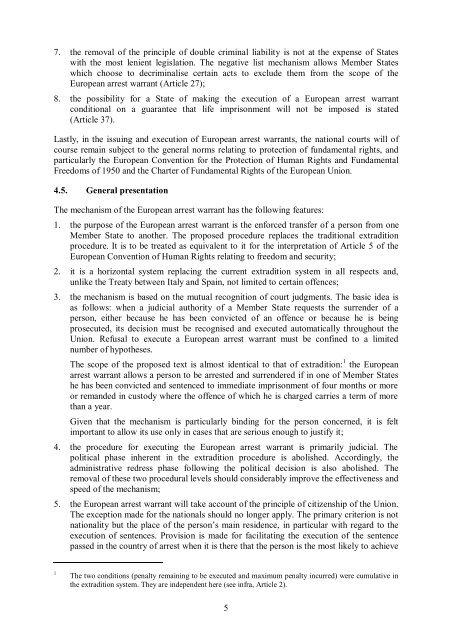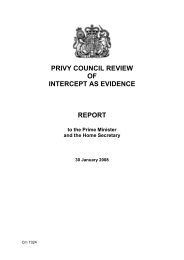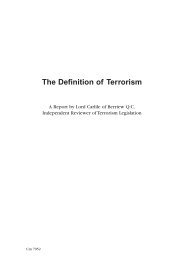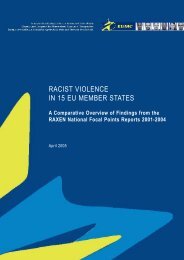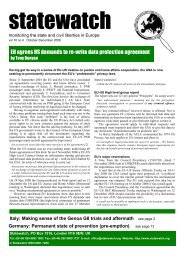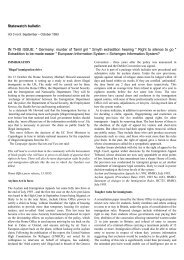the European arrest warrant - Statewatch
the European arrest warrant - Statewatch
the European arrest warrant - Statewatch
You also want an ePaper? Increase the reach of your titles
YUMPU automatically turns print PDFs into web optimized ePapers that Google loves.
7. <strong>the</strong> removal of <strong>the</strong> principle of double criminal liability is not at <strong>the</strong> expense of States<br />
with <strong>the</strong> most lenient legislation. The negative list mechanism allows Member States<br />
which choose to decriminalise certain acts to exclude <strong>the</strong>m from <strong>the</strong> scope of <strong>the</strong><br />
<strong>European</strong> <strong>arrest</strong> <strong>warrant</strong> (Article 27);<br />
8. <strong>the</strong> possibility for a State of making <strong>the</strong> execution of a <strong>European</strong> <strong>arrest</strong> <strong>warrant</strong><br />
conditional on a guarantee that life imprisonment will not be imposed is stated<br />
(Article 37).<br />
Lastly, in <strong>the</strong> issuing and execution of <strong>European</strong> <strong>arrest</strong> <strong>warrant</strong>s, <strong>the</strong> national courts will of<br />
course remain subject to <strong>the</strong> general norms relating to protection of fundamental rights, and<br />
particularly <strong>the</strong> <strong>European</strong> Convention for <strong>the</strong> Protection of Human Rights and Fundamental<br />
Freedoms of 1950 and <strong>the</strong> Charter of Fundamental Rights of <strong>the</strong> <strong>European</strong> Union.<br />
4.5. General presentation<br />
The mechanism of <strong>the</strong> <strong>European</strong> <strong>arrest</strong> <strong>warrant</strong> has <strong>the</strong> following features:<br />
1. <strong>the</strong> purpose of <strong>the</strong> <strong>European</strong> <strong>arrest</strong> <strong>warrant</strong> is <strong>the</strong> enforced transfer of a person from one<br />
Member State to ano<strong>the</strong>r. The proposed procedure replaces <strong>the</strong> traditional extradition<br />
procedure. It is to be treated as equivalent to it for <strong>the</strong> interpretation of Article 5 of <strong>the</strong><br />
<strong>European</strong> Convention of Human Rights relating to freedom and security;<br />
2. it is a horizontal system replacing <strong>the</strong> current extradition system in all respects and,<br />
unlike <strong>the</strong> Treaty between Italy and Spain, not limited to certain offences;<br />
3. <strong>the</strong> mechanism is based on <strong>the</strong> mutual recognition of court judgments. The basic idea is<br />
as follows: when a judicial authority of a Member State requests <strong>the</strong> surrender of a<br />
person, ei<strong>the</strong>r because he has been convicted of an offence or because he is being<br />
prosecuted, its decision must be recognised and executed automatically throughout <strong>the</strong><br />
Union. Refusal to execute a <strong>European</strong> <strong>arrest</strong> <strong>warrant</strong> must be confined to a limited<br />
number of hypo<strong>the</strong>ses.<br />
The scope of <strong>the</strong> proposed text is almost identical to that of extradition: 1 <strong>the</strong> <strong>European</strong><br />
<strong>arrest</strong> <strong>warrant</strong> allows a person to be <strong>arrest</strong>ed and surrendered if in one of Member States<br />
he has been convicted and sentenced to immediate imprisonment of four months or more<br />
or remanded in custody where <strong>the</strong> offence of which he is charged carries a term of more<br />
than a year.<br />
Given that <strong>the</strong> mechanism is particularly binding for <strong>the</strong> person concerned, it is felt<br />
important to allow its use only in cases that are serious enough to justify it;<br />
4. <strong>the</strong> procedure for executing <strong>the</strong> <strong>European</strong> <strong>arrest</strong> <strong>warrant</strong> is primarily judicial. The<br />
political phase inherent in <strong>the</strong> extradition procedure is abolished. Accordingly, <strong>the</strong><br />
administrative redress phase following <strong>the</strong> political decision is also abolished. The<br />
removal of <strong>the</strong>se two procedural levels should considerably improve <strong>the</strong> effectiveness and<br />
speed of <strong>the</strong> mechanism;<br />
5. <strong>the</strong> <strong>European</strong> <strong>arrest</strong> <strong>warrant</strong> will take account of <strong>the</strong> principle of citizenship of <strong>the</strong> Union.<br />
The exception made for <strong>the</strong> nationals should no longer apply. The primary criterion is not<br />
nationality but <strong>the</strong> place of <strong>the</strong> person’s main residence, in particular with regard to <strong>the</strong><br />
execution of sentences. Provision is made for facilitating <strong>the</strong> execution of <strong>the</strong> sentence<br />
passed in <strong>the</strong> country of <strong>arrest</strong> when it is <strong>the</strong>re that <strong>the</strong> person is <strong>the</strong> most likely to achieve<br />
1<br />
The two conditions (penalty remaining to be executed and maximum penalty incurred) were cumulative in<br />
<strong>the</strong> extradition system. They are independent here (see infra, Article 2).<br />
5


